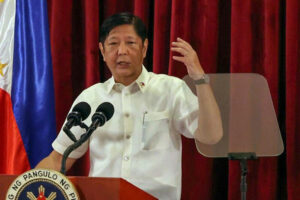PARTICIPATING in more free trade arrangements will be the key to making the Philippines an export hub, President Ferdinand R. Marcos, Jr. said, adding that attaining reciprocity with future trading partners will require opening up the economy to some extent.
Speaking to reporters on the sidelines of a trade forum, Mr. Marcos said the government’s economic managers are undertaking a study of the best practices of leading export economies that have benefited from free trade deals.
The Philippines will soon be signing a free trade agreement (FTA) with South Korea, and is targeting FTAs with the European Union and the US, Mr. Marcos added.
“We want to open markets so that the Philippines will be able to export to and import from (trading partners). So it’s not one way,” he said.
“What we have to do is to allow ourselves to restructure some of the elements within (the bounds of) the law… so that we can compete on an even basis.”
Aside from being suppliers, Philippine exporters should also become “industrial consumers” of products sold by trading partners, Mr. Marcos said.
“That is why we have to (raise) our export game… and support our exporters so they can compete in foreign markets… not only as suppliers, but also industrial consumers,” he said. “In other words, to strengthen trade.”
During the forum, the Department of Trade and Industry (DTI) launched the blueprint for the Philippine export sector.
Mr. Marcos said at the event that the Philippine Export Development Plan calls for various government interventions, such as infrastructure development, greater ease of doing business, promotion and marketing, financing, and even legislative initiatives, among others.
“The growth of our very own export industry holds the key to our attainment of national development targets,” he said in his speech. “So cognizant of our pivotal role, we have to make sure that this ‘economic linchpin,’ that we are counting on for so much, will be properly and firmly in place.”
Mr. Marcos noted that the Philippines lags its Southeast Asian neighbors in export success.
“It is true our total exports are growing. However, within the larger context of international trade, we fall behind our ASEAN neighbors,” he said, noting that Manila still grapples with critical issues “such as a comparatively less-diversified export portfolio and trade barriers and frictions.”
He stressed the need to diversify exports, noting that “40% of all our exports are only one product.”
“So the level of diversification is something that we have to look at and we have to improve in the coming years,” he said.
Electronics are the Philippines’ largest exports, with Mr. Marcos understating the extent of the country’s export dependence on the industry. Electronics exports last year hit $49.09 billion, against overall exports of $78.8 billion.
Mr. Marcos said the Philippines has had several good export plans “but nonetheless we are still playing catch-up in the global scene.”
“It is high time that we confront and address these issues head-on.”
The Philippines imports much of its food and farm inputs, making it vulnerable to imported inflation.
Mr. Marcos said he sees great promise in the export sector, estimating the “untapped” potential for exports at $49 billion. He added that small businesses will play a key role in boosting the sector.
“It has become clearer to us what the evolving export landscape looks like now. Our role in the global marketplace is becoming more apparent,” he said. “We are more aware about the normal exigencies of trade and commercial dealings in our relations with other countries.”
Under the plan, the government will enforce “industry-level” interventions to address challenges facing the sector, Trade Secretary Alfredo E. Pascual told reporters earlier.
He said his department is also looking into company-level interventions “because we believe that we need to work closely with individual firms to be able to take care of their needs as they venture into a potential export business for their companies.”
Under the Export Development Act of 1994, the DTI must prepare a rolling three-year plan for the export sector. The plan forms part of the Medium-Term Philippine Development Plan, which is now called the Philippine Development Plan.
Mr. Marcos backed his economic managers’ view that exporters will benefit from the Regional Comprehensive Economic Partnership (RCEP).
RCEP, which Manila ratified in April, covers nearly a third of the global population and about 30% of the world’s gross domestic product. It took effect in the Philippines on June 2.
RCEP members include the Association of Southeast Asian Nations (ASEAN), Australia, China, Japan, New Zealand and South Korea.
The trade deal is heavily supported by China, whose trade with member countries, according to a May 2022 analysis from China Briefing, accounted for 30% of Beijing’s total foreign trade by value.
Critics of RCEP have warned that the trade deal will make the Philippines heavily reliant on imports from China and prevent it from achieving trade diversification.
The Philippines is expected to face declining imports from Southeast Asia and rising imports from China and South Korea due to RCEP, the Philippine Institute for Development Studies (PIDS) said in a 2021 paper.
Likely imports will be arms and ammunition, electrical machinery and equipment, and plastics from South Korea, PIDS said.
From China, the Philippines is expected to import plastics, rubber, apparel and textiles, footwear, glass and glassware, machinery and mechanical appliances, electrical machinery and equipment, it added.
The institute said imports from China will increase all over Southeast Asia, except for Laos and Vietnam.
“Among ASEAN members, Malaysia will potentially have the largest increase in imports ($3.7 billion yearly), followed by Cambodia ($2.3 billion) and Thailand ($876 million),” it said. — Kyle Aristophere T. Atienza

